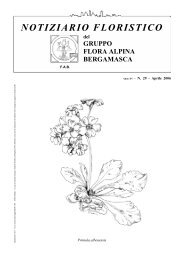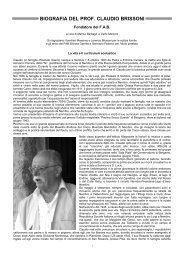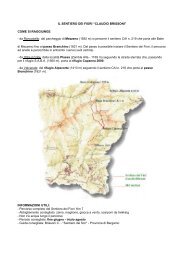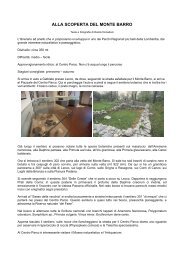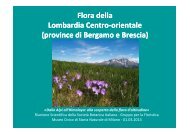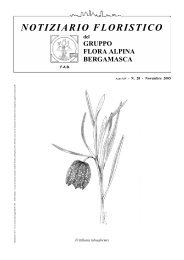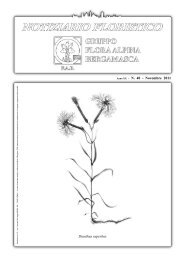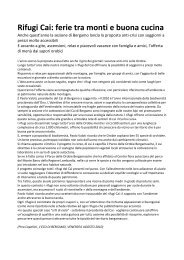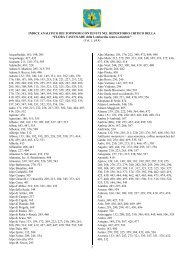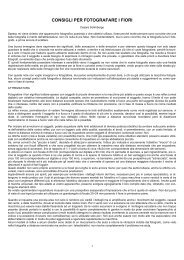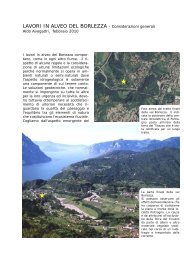IBI 40 Supplemento 1 (2008) - Gruppo Flora Alpina Bergamasca
IBI 40 Supplemento 1 (2008) - Gruppo Flora Alpina Bergamasca
IBI 40 Supplemento 1 (2008) - Gruppo Flora Alpina Bergamasca
Create successful ePaper yourself
Turn your PDF publications into a flip-book with our unique Google optimized e-Paper software.
170 INFORMATORE BOTANICO ITALIANO, <strong>40</strong> SUPPL. 1, <strong>2008</strong><br />
(FISCHER, MATTHIES, 1998a; KÉRY et al., 2000;<br />
KÉRY, MATTHIES, 2004; BECKER 2005). There are<br />
several possible explanations for this reduced reproduction:<br />
(1) Environmental conditions may be worse<br />
at sites with small populations. However, we found<br />
no evidence for this. (2) Small populations may be<br />
less attractive for pollinators. There was evidence for<br />
pollination problems for some of the studied species.<br />
(3) The reduced reproduction may indicate inbreeding<br />
depression. That genetic problems may play a<br />
role was indicated by the reduced fitness of offspring<br />
from small populations in comparison to that from<br />
large populations in common garden studies<br />
(FISCHER, MATTHIES, 1998a; BECKER, 2005).<br />
Moreover, in Gentianella germanica, a species for<br />
which this was studied, we found reduced molecular<br />
genetic variability in small populations (FISCHER,<br />
MATTHIES, 1998b), indicating the loss of genetic<br />
variability through drift.<br />
Reduced reproduction may not affect the performance<br />
of populations in the field if they are not seedlimited,<br />
and even a reduced fitness of offspring in a<br />
common garden is only an indication of potential<br />
problems. However, we studied the growth rate of<br />
field populations of one of the species, Gentianella<br />
germanica, and found that small populations had a<br />
lower growth rate, indicating that these problems<br />
already affect the survival probability of field populations<br />
(FISCHER, MATTHIES, 1998a). Fragmentation<br />
has many detrimental effects on plant populations,<br />
but it may also result in a lower abundance of insect<br />
parasites and fungal pathogens in fragmented populations<br />
(KÉRY et al., 2001; COLLING, MATTHIES, 2004).<br />
Because the risk of extinction is expected to increase<br />
with decreasing number of individuals in a population,<br />
population size plays a central role in the assessment<br />
of the effects of fragmentation. There are two<br />
principal approaches to investigate the relationship<br />
between population size and the risk of extinction:<br />
(1) Stochastic simulations of the population dynamics<br />
on the basis of empirical demographic data, and<br />
(2) an empirical analysis of the extinction of populations<br />
over a period of time in relation to their size. In<br />
my presentation I will present examples for both<br />
approaches. An example of the first approach is the<br />
analysis of the demography of the rare long-lived<br />
plant Scorzonera humilis in Luxembourg. The risk of<br />
extinction over 100 years differed strongly among<br />
the studied populations indicating that there is no<br />
general rule for a size of a viable population<br />
(COLLING, MATTHIES, 2006).<br />
An empirical analysis of the relationship between<br />
population size and risk of extinction requires longterm<br />
data on the population size and survival, which<br />
are rarely available. A notable exception is the program<br />
to monitor the populations of rare plants in the<br />
German state of Lower Saxony. We used data from<br />
this program as a basis to study the relation between<br />
population size and extinction in plants. For seven<br />
rare species the probability of a population to survive<br />
over a ten-year period increased significantly with its<br />
size at the begin of the study. However, the minimum<br />
population size for a probability of survival of<br />
90% over ten years varied from 70 - 1300 individuals<br />
among species, again indicating that there may be<br />
no general rules for the size of minimum viable plant<br />
populations (MATTHIES et al., 2004).<br />
The mean size of the surviving populations, with the<br />
exception of those of Gentianella germanica, did not<br />
decline over the study period, but was similar, or<br />
even increased. This was also true for populations<br />
that had been small (< 100 individuals) at the beginning<br />
of the study. This suggests that not a general<br />
deterministic decline in habitat quality was responsible<br />
for the fate of the populations that became<br />
extinct, but that extinction had a strong stochastic<br />
component (MATTHIES et al., 2004).<br />
Plant species with a large area of distribution may<br />
either consist of a strongly plastic general purpose<br />
genotype or may consist of ecotypes that are adapted<br />
to specific regional or even local environmental conditions.<br />
In a large European project, we studied the<br />
scale of adaptation using the declining plant Carlina<br />
vulgaris as a model species (BECKER et al., 2006a).<br />
Offspring from 74 populations from seven European<br />
regions (S-Sweden, S-Britain, C-Netherlands, C-<br />
Germany, W-Czechia, Luxembourg and N-<br />
Switzerland) was grown in a common garden. There<br />
was strong morphological variation among the plants<br />
from the different regions, but also among populations<br />
within regions and families within populations.<br />
This variation could be due to random genetic drift,<br />
or it could be adaptive. To study possible adaptations,<br />
reciprocal transplant experiments were conducted<br />
both at the European and the regional scale.<br />
Seedlings were transplanted into their home and into<br />
the other six regions, and within each region,<br />
seedlings were reciprocally transplanted among several<br />
populations. The results showed that C. vulgaris<br />
consists of regionally adapted genotypes. Native<br />
genotypes had a higher fitness at their home site than<br />
foreign genotypes, and the fitness of plants decreased<br />
with the distance between the population of origin<br />
and the transplant site. However, there was no evidence<br />
for adaptation to local conditions within<br />
regions. Similar results were found for a common<br />
species, Hypochoeris radicata (BECKER, 2005) The<br />
results suggest that reintroduction programs should<br />
use local material whenever possible to avoid problems<br />
of maladaptation, but should consider the<br />
potential problems of both inbreeding and outbreeding<br />
depression (FISCHER, MATTHIES, 1997; BECKER<br />
et al., 2006b) .<br />
Because populations in European regions are genetically<br />
different from each other, efforts should be<br />
made to conserve species where they have become<br />
rare, even if they are still common in other regions.<br />
The results also suggest that regional Red Data Lists<br />
are important.<br />
The ongoing nutrient enrichment of many habitats<br />
is a problem both in Europe and worldwide. In<br />
Central Europe nutrient enrichment is a very important<br />
cause of the decline of species, because most<br />
plant species require nutrient-poor conditions. The



